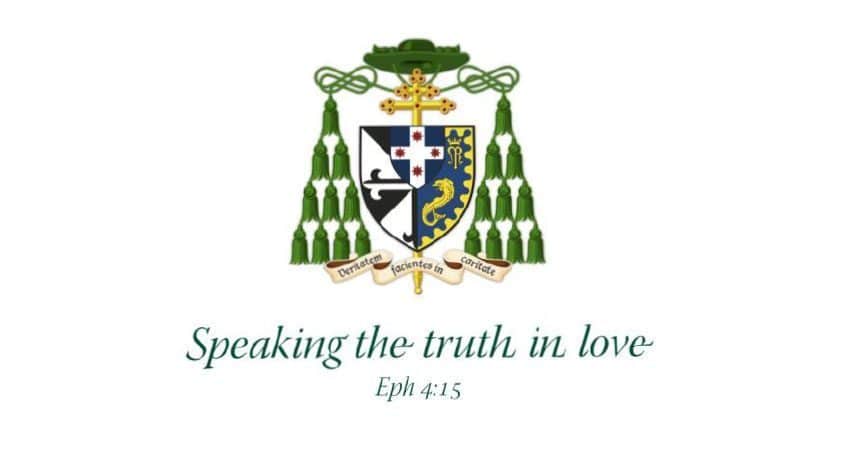HOMILY FOR MASS OF THE HOLY NAME OF MARY IN THANKSGIVING FOR THE INSTALLATION OF MOST REV. CHRIS CARDONE OP AS ARCHBISHOP OF HONIARA – HOLY CROSS CATHEDRAL, HONIARA

My thanks to His Grace the Archbishop of Honiara, Most Rev. Chris Cardone OP, for the honour of preaching at this Mass of Thanksgiving. I have known Archbishop Chris since the 1980s when I was a student in the Dominican Order and he was a newly-minted priest. This Oceania province of the Dominicans had asked the North-Eastern American province to provide two men to assist with the mission to the Solomon Islands, preferably ones who could pilot a boat and read a compass. Chris was chosen, I understand, because he came from Long Island (and so was presumed to know about islands), had been an Eagle Scout (and so was presumed to be able to read a compass) and so was fully qualified! It also helped that he knew a thing or two about the Catholic faith and had a passion for sharing it with others.
I remember well his excitement when he arrived ‘down under’ and how much he loved his service amongst the people of the Diocese of Gizo. I also remember hearing that the people were desolate at the prospect of his return to America when his time was up. As that time approached, they cleverly hatched a plan to keep him in the Solomons by making him a Bishop, and since Gizo he has served in Auki and will now serve here in Honiara.
This week I will celebrate 25 years since I was ordained a priest by Bishop Eusebius Crawford OP, the first Bishop of Gizo; earlier this year I marked 30 years since I was clothed in the Dominican habit by Father Bernard O’Grady OP, who was to become the second Bishop of Gizo, and who was to teach ‘bishoping’ to Archbishop Chris. So in a sense sense I feel the Solomon Islands have been following me around in my vocation on the beginning! It was therefore a very special joy to be able to join His Grace and all of you at yesterday’s very joyful celebration of his Installation as Metropolitan Archbishop. I congratulate him as well as his family, friends, religious congregation, and new flock on his new appointment. I bring with me the greetings and congratulations of all the bishops of the small island to the south of SIPNG – Australia.
During a Q&A for young people a few years ago I was asked whether swearing was still a sin. Leaving aside the idea that some things that used to be spiritual crimes have been repealed – by opinion poll or theologians – I was interested that someone might think it’s OK to use bad language, including the names of God, Mary and the saints, to express strong emotions or simply as seafood filler for conversations. Only a generation ago swearing was one of the most confessed sins: not just because it was common but also because people were properly sensitive to sins especially against God. Since hardly anyone worshipped idols anymore or attempted to kill their parish priest – though the latter may sometimes have been tempting – swearing was the most likely breach by an ordinary person of the first tablet of the Law of Moses: the commandments regarding reverence for God and the things of God.
But why worry about the way we use the Most Holy Name of Jesus or the Holy Name of Mary? Are we superstitiously fearful that misusing certain words will bring a curse on us or those around us? Are we afraid of hurting God’s feelings or Mary’s feelings, so that they will sulk and no longer help us? No, I think our repugnance to swearing is an extension of how it feels to us when someone speaks badly about our own father or mother. We may tell children that “sticks and stones can break my bones but names will never hurt me” but our children know, as we know, that being named Paramount Chief or Metropolitan Archbishop honours someone and being called a bad name can wound them or damage their reputation amongst their neighbours.
So, from the beginning of the Bible it is recognized that naming is a powerful thing: God names the night and the day, the skies and land and seas, and the first man; Adam is given the job of naming the plants and animals, and even his own wife and children; with these names he makes sense of things, communicates them to others and with his wife Eve exercises stewardship over creation. Words, we all know, can describe dreams and realities, build understanding and friendships; or they can be used as weapons to defame and gossip. The task of your new Archbishop will be in some ways like that of Adam: to name things honestly as they are, both good and bad; to help make sense of the things of God and creation and ourselves; and to exercise with his wife, the Church, stewardship over the people and things of these parts.
The Solomon Islands are dedicated to the patronage of the Holy Name of Mary. Often in the Bible to name someone is to call them: Abram is renamed Abraham when God makes a new covenant with him (Gen 17:5); Simon is renamed Peter when Christ gives a new mission to him (Mt 16:18); Zechariah is restored when he names his boy John the forerunner of Christ (Lk 1:63-64); and when the risen Jesus speaks her name, Mary Magdalene recognises Him and goes off proclaiming the Resurrection (Jn 20:16). The origin of the name Mary is debated by scholars. Some think it comes from the Egyptian word for bitterness from which we get our word myrrh. But the Aramaic name ܡܪܝܡ (Maryam) and Hebrew name מִרְיָם (Miriam) mean beloved or blessed rather than bitter, and this is the name given Moses’ sister and several women associated with Jesus, especially His own mother.
The name of Mary the mother of Jesus appears twenty times in the New Testament, honouring her as ‘the most blessed of all women’, the one ‘full of grace’ and the Holy Spirit, who came to the aid of those in need at Cana and at the cross and has been assisting Christians ever since. Above all, she is called Beloved or Blessed Mary because she was the Θεοτόκος (Theotokos) or God-bearer: she gave her flesh and love to the Baby Jesus, carrying Him in her heart and womb, and bringing Him forth for the world. There is another name very like Theotokos or God-bearer: Χριστόφορος (Christoforos) or Christ-bearer and that is the name of your new Archbishop, Christopher: his mission, like that of Mary, is to give his life and love to the Baby Jesus, to carry Him in his heart and mind, and to bear Him forth for the world, especially for the people of Honiara.
The first Dominicans came to this region in the 16th century, settling in Flores, Timor and Solor, and gradually making their way to the Solomons by the mid-20th century. By then it was thoroughly Marist territory, as the first Marist missionaries came to these islands a century before under the leadership of Bishop Jean-Baptiste Épalle. Apart from being Pacific adventurers and missionaries, the two orders shared a common devotion to Mary: Dominicans promoted devotion to the Holy Rosary and Marists dedicated their lives to imitating Mary ‘in all things’. Because the name Maria sounds like the Latin word Mare, the sea, and for other reasons, Mary came to be known as “the Star of the Sea” or Protectress of people who live on and by the sea. And so it was only natural that missionaries from the Marist and Dominican orders would call on her aid in the difficult task of navigating the seas and the customs of the new people they met in the Solomons, teaching the faith while learning as much from the native peoples as they were teaching them.
Catholics in this country ever since have relied on the intercession of their heavenly Mother during natural disasters such as earthquakes and storms, through the horrors of the Second World War, and during times of economic uncertainty or political unrest. Today is 9-11, the 15th anniversary of the terrible events in New York and Washington DC on 11 September: at that time in the Archbishop’s place of origin and all over the world people turn to Mary to pray for peace and safety. Whether hearing the Solomons or far away Catholics have always known in their troubles that Mary has stood and understood; she has been your model of faith and hope and love. Through the bitter storms of daily life as much as the storms of the sea, we turn to this love it and blessed one, even as she points us first and foremost to her divine Son.
I ask you all to care for your new Shepherd, or should I say your new Ship’s Captain, even as he cares for you. As you follow his lead in docility and obedience, counsel and teach him yourselves so that he may be the best Archbishop he can be for you. Support him with your affections, your labours and resources, and with your prayers. Join me today in commending him to Mary’s maternal care as he leads, teaches and sanctifies you; as he unites you in communion with the Holy Father, the bishops and all Christians throughout the world, and the communion of saints in heaven; as he builds up the growing Church in the Solomons and helps you build up your society. As St. Bernard of Clairvaux said: “In dangers, in anguish, in doubt, think of Mary, call upon Mary. Let her name be ever on your lips, ever in your heart; and the better to obtain the help of her prayers, imitate the example of her life. Following her, you do not stray; invoking her, you do not despair; thinking of her, you do not wander; upheld by her, you do not fall; shielded by her, you do not fear; guided by her, you do not grow weary; favoured by her, you reach the goal. And thus do you experience in yourself how good is that saying: ‘And the Virgin’s name was Mary.'”
God bless you, Your Grace, in your new mission. God bless the Church of Honiara and all the Solomon Islands!

